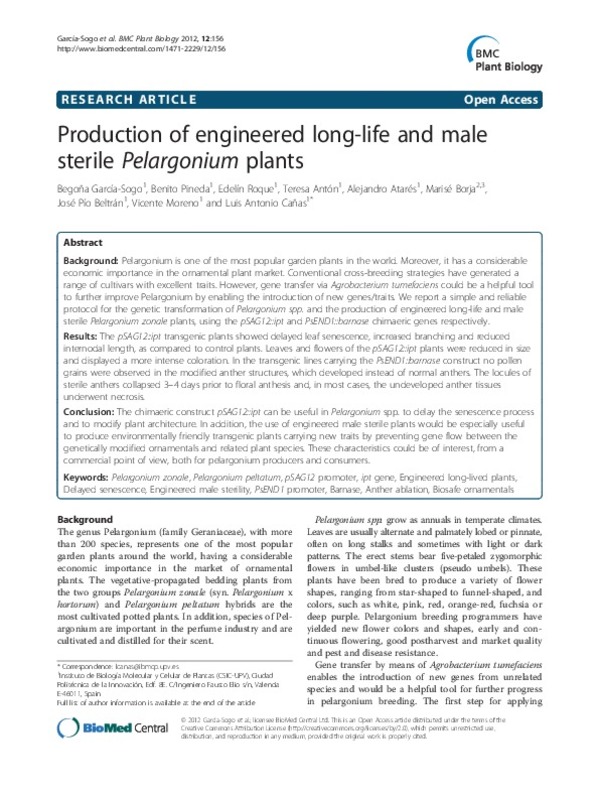García Sogo, B.; Pineda Chaza, BJ.; Roque Mesa, EM.; Antón Martínez, MT.; Atarés Huerta, A.; Borja, M.; Beltran Porter, JP.... (2012). Production of engineered long-life and male sterile Pelargonium plants. BMC Plant Biology. 12:156-171. https://doi.org/10.1186/1471-2229-12-156
Por favor, use este identificador para citar o enlazar este ítem: http://hdl.handle.net/10251/31752
|
Título:
|
Production of engineered long-life and male sterile Pelargonium plants
|
|
Autor:
|
García Sogo, Begoña

 Pineda Chaza, Benito José
Roque Mesa, Edelin Marta
Antón Martínez, María Teresa
Pineda Chaza, Benito José
Roque Mesa, Edelin Marta
Antón Martínez, María Teresa

 Atarés Huerta, Alejandro
Borja, Marisé
Atarés Huerta, Alejandro
Borja, Marisé
 Beltran Porter, Jose Pio
Beltran Porter, Jose Pio

 Moreno Ferrero, Vicente
Moreno Ferrero, Vicente
 Cañas Clemente, Luís Antonio
Cañas Clemente, Luís Antonio
|
|
Entidad UPV:
|
Universitat Politècnica de València. Departamento de Biotecnología - Departament de Biotecnologia
Universitat Politècnica de València. Instituto Universitario Mixto de Biología Molecular y Celular de Plantas - Institut Universitari Mixt de Biologia Molecular i Cel·lular de Plantes
|
|
Fecha difusión:
|
|
|
Resumen:
|
[EN] Background: Pelargonium is one of the most popular garden plants in the world. Moreover, it has a considerable
economic importance in the ornamental plant market. Conventional cross-breeding strategies have generated ...[+]
[EN] Background: Pelargonium is one of the most popular garden plants in the world. Moreover, it has a considerable
economic importance in the ornamental plant market. Conventional cross-breeding strategies have generated a
range of cultivars with excellent traits. However, gene transfer via Agrobacterium tumefaciens could be a helpful tool
to further improve Pelargonium by enabling the introduction of new genes/traits. We report a simple and reliable
protocol for the genetic transformation of Pelargonium spp. and the production of engineered long-life and male
sterile Pelargonium zonale plants, using the pSAG12::ipt and PsEND1::barnase chimaeric genes respectively.
Results: The pSAG12::ipt transgenic plants showed delayed leaf senescence, increased branching and reduced
internodal length, as compared to control plants. Leaves and flowers of the pSAG12::ipt plants were reduced in size
and displayed a more intense coloration. In the transgenic lines carrying the PsEND1::barnase construct no pollen
grains were observed in the modified anther structures, which developed instead of normal anthers. The locules of
sterile anthers collapsed 3¿4 days prior to floral anthesis and, in most cases, the undeveloped anther tissues
underwent necrosis.
Conclusion: The chimaeric construct pSAG12::ipt can be useful in Pelargonium spp. to delay the senescence process
and to modify plant architecture. In addition, the use of engineered male sterile plants would be especially useful
to produce environmentally friendly transgenic plants carrying new traits by preventing gene flow between the
genetically modified ornamentals and related plant species. These characteristics could be of interest, from a
commercial point of view, both for pelargonium producers and consumers.
[-]
|
|
Palabras clave:
|
Pelargonium zonale
,
Pelargonium peltatum
,
pSAG12 promoter
,
ipt gene
,
Engineered long-lived plants
,
Delayed senescence
,
Engineered male sterility
,
PsEND1 promoter
,
Barnase
,
Anther ablation
,
Biosafe ornamentals
|
|
Derechos de uso:
|
Reconocimiento (by)
|
|
Fuente:
|
BMC Plant Biology. (issn:
1471-2229
)
|
|
DOI:
|
10.1186/1471-2229-12-156
|
|
Editorial:
|
BioMed Central
|
|
Versión del editor:
|
http://dx.doi.org/10.1186/1471-2229-12-156
|
|
Código del Proyecto:
|
info:eu-repo/grantAgreement/MICINN//AGL2009-13388-C03-01/ES/Generacion De Mutantes De Insercion De Tomate Cultivado Y Silvestre E Identificacion De Genes Implicados En Procesos Del Desarrollo Y Tolerancia A Estres Abiotico/
info:eu-repo/grantAgreement/MICINN//BIO2009-08134/ES/Mejora Del Valor Nutritivo De La Alfalfa (Medicago Sativa L.) Mediante Ingenieria Genetica/
|
|
Agradecimientos:
|
This work was funded by grants AGL2009-13388-C03-01 and BIO2009-08134 from the Spanish Ministry of Science and Innovation (MICINN). We acknowledge support of the publication fee by the CSIC Open Access Publication Support ...[+]
This work was funded by grants AGL2009-13388-C03-01 and BIO2009-08134 from the Spanish Ministry of Science and Innovation (MICINN). We acknowledge support of the publication fee by the CSIC Open Access Publication Support Initiative through its Unit of Information Resources for Research (URICI).
In the past five years we have received funding from the Spanish Ministry of Science and Innovation (MICINN) and the article-processing charge will be pay with funds from two granted projects. The authors received salaries from two different institutions: The Polytechnic University of Valencia (UPV) or the High Spanish Council of Scientific Research (CSIC). We are not currently applying for a patent related with the content of this manuscript. All the mentioned organisms/institutions do not gain or lose financially from the publication of this manuscript either now or in the future.
[-]
|
|
Tipo:
|
Artículo
|









